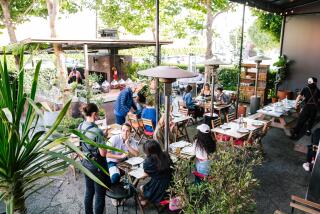The Simpatico Patio : A Taste for All Things Modern Revives Mid-Century Furniture Designed for the Outdoors
- Share via
Take a hike, teak. Goodbye, granite, mossed marble and overwrought iron. There’s some new garden furniture in town, and its look is simply modern.
Riding the wave of current tastes for the clean lines and curves of furnishings from the 1930s through the ‘60s, yesterday’s outdoor treasures have become today’s hot patio seats. “They’re sculptural objects that also perform a function,” says Ken Erwin, owner of A.K. Eleven 14 in Venice, a store that specializes in furniture from the 1920s to the present. According to Erwin, the pared-down elegance of poolside chaise longues and chairs by designers such as Richard Schultz, Walter Lamb and Van Keppel-Green reflect the postwar American dream of living large--with the doors open. “Southern California had the perfect climate, as well as many great modern houses by architects like Rudolph Schindler, Richard Neutra and Craig Ellwood,” Erwin says. “Rustic garden furniture didn’t suit them.”
In fact, it was partly the lack of suitable outdoor seats that fueled the mid-century creative push to produce them. Andy Hackman, who, with his partner, Kathy Guild, recently opened a Los Angeles furniture shop called outside, points out that “there weren’t a lot of options then, and it suddenly seemed as if everyone began to dabble in patio furniture.”
“Everyone” included Neutra himself, who produced a line of extruded-aluminum loungers, and other designers such as Milo Baughman and Greta Grossman, whose pieces were meant to travel between house and garden. “As the division between indoors and out became blurred by sliding glass walls, there was a freer way of thinking about furniture,” Hackman explains.
Creative license, he adds, was further encouraged by the availability of interesting materials that were either rationed or developed during World War II. These included aluminum, tubular steel, wrought iron and vinyl. What designers aimed to do with them was to make simple, fluid structures that appeared seamless and were relatively easy and inexpensive to manufacture.
Among the hallmarks of the time that are sought-after today are pieces by Hendrik Van Keppel and Taylor Green. Their graceful loungers--consisting of a steel frame tightly wrapped in 1/8-inch-wide yacht cord--became, Hackman says, “the ubiquitous furnishings outside houses in the Case Study program,” which showcased some of California’s best modern residential architecture. Another high-profile, mid-century design, this one from Brown Jordan, featured canvas webbing stretched in a grid over a metal frame, while Richard Schultz paired woven mesh with cast aluminum and steel.
Since patio furniture takes a beating from the elements, some of these classics reach the market a bit shabby after nearly 50 years. Which is why outside restores pieces using updated materials such as powder-coated metals and rot-resistant synthetic wraps. Hackman and Guild even plan to produce new pieces in the spirit of some of their favorites.
It’s still possible to find poolside treasures at swap meets or flea markets if you don’t mind rust or missing straps. But given the competition, whatever you find won’t come cheap. “In a strong economy,” Erwin says, “people gravitate toward simplicity. In hard times, they want fantasy. But right now, we have the confidence to go back to straightforward good design.”


